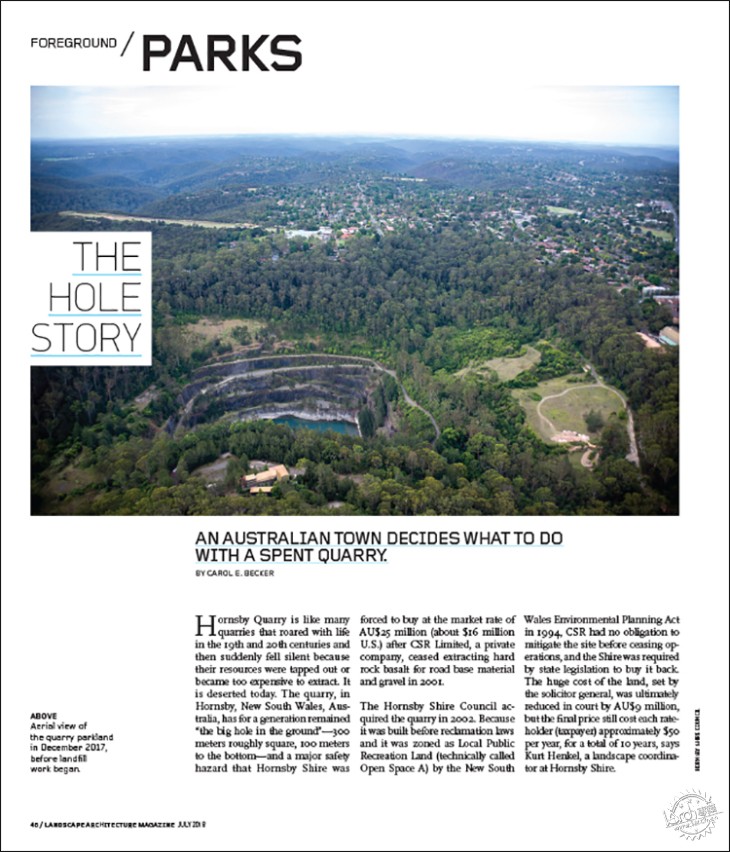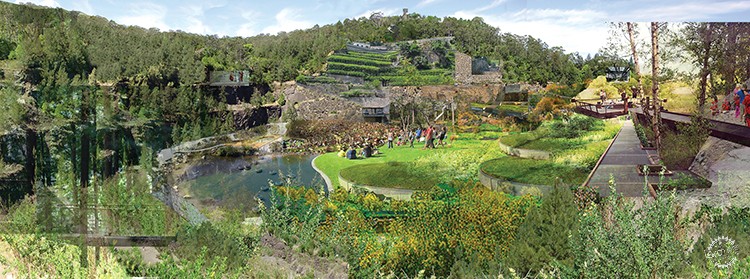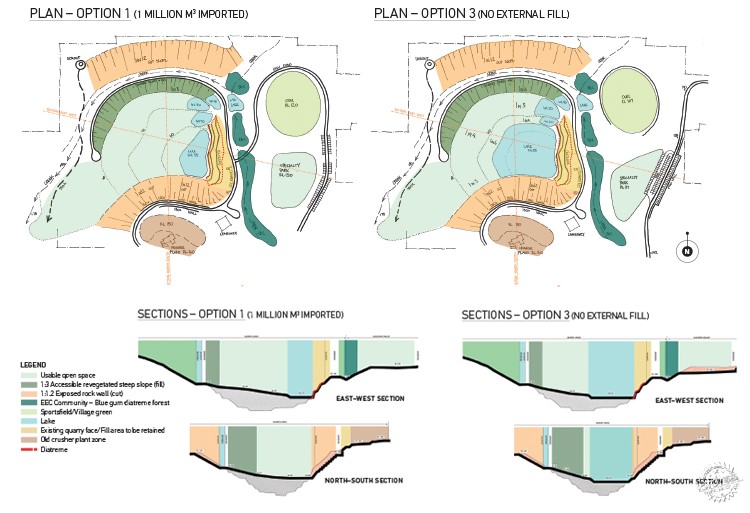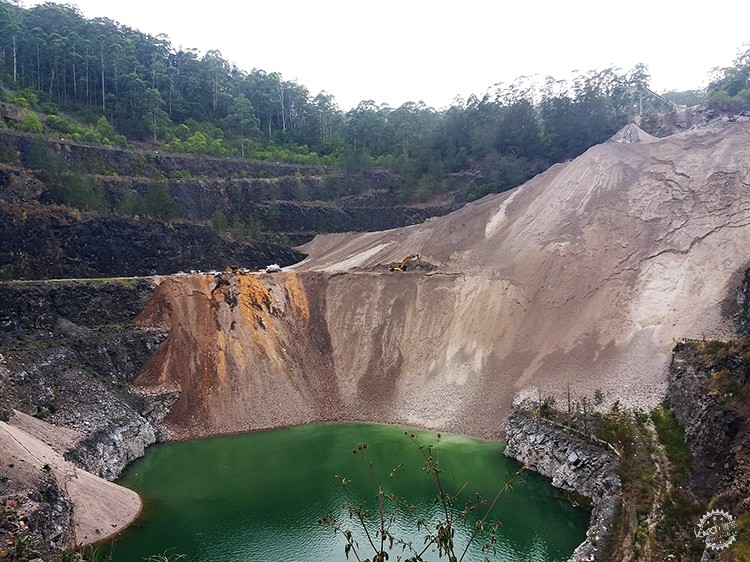
THE HOLE STORY BY CAROL E. BECKER
由专筑网胡婧宜,李韧编译
Hornsby 采石场就像许多采石场一样,在19世纪和20世纪得以迅速发展,然后陷入停滞,部分原因是因为挖掘出来的资源变得太昂贵而无法提取。这里如今依然很冷清。这座采石场位于澳大利亚新南威尔士州的Hornsby,成为了一代人记忆中的“地表大洞”,一个约100平方米、深100米的大洞,这也是Hornsby郡在2001年以2500万澳元的市场价购买了采石场后所面临的一个巨大威胁,在此之前CSR责任有限公司刚刚停止挖掘硬石。
Hornsby郡议会于2002年收购了该采石场。该场地在填海法制定之前建成,并于1994年被新南威尔士环境规划法划为地方公共娱乐用地,技术上称为A类开放空间,因此CSR公司没有义务在停止运行之前减少开采量,州政府只能要求郡政府购买它。“由法律顾问设定的巨额土地成本最终在法庭上减少了900万澳元,但最终价格仍然花费每个纳税人每年大约50美元,共计10年。”Hornsby 郡的景观协调员Kurt Henkel这样说。
然而,采石场不会处于休眠状态。其物质、历史,乃至地理特性都对澳大利亚的发展产生了影响,并寻求通过大胆的方式叙述给后人。Hornsby 采石场的愿景是从意外发现的经济矿坑转型成为新型的公园,它将是关于政治、地质、遗迹、保护,当然还有景观的公园,这里将成为有趣的尝试。
FROM THE JULY 2018 ISSUE OF LANDSCAPE ARCHITECTURE MAGAZINE.
Hornsby Quarry is like many quarries that roared with life in the 19th and 20th centuries and then suddenly fell silent because their resources were tapped out or became too expensive to extract. It is deserted today. The quarry, in Hornsby, New South Wales, Australia, has for a generation remained “the big hole in the ground”—300 meters roughly square, 100 meters to the bottom—and a major safety hazard that Hornsby Shire was forced to buy at the market rate of AU$25 million (about $16 million U.S.) after CSR Limited, a private company, ceased extracting hard rock basalt for road base material and gravel in 2001.
The Hornsby Shire Council acquired the quarry in 2002. Because it was built before reclamation laws and it was zoned as Local Public Recreation Land (technically called Open Space A) by the New South Wales Environmental Planning Act in 1994, CSR had no obligation to mitigate the site before ceasing operations, and the Shire was required by state legislation to buy it back. The huge cost of the land, set by the solicitor general, was ultimately reduced in court by AU$9 million, but the final price still cost each rate-holder (taxpayer) approximately $50 per year, for a total of 10 years, says Kurt Henkel, a landscape coordinator at Hornsby Shire.
The quarry will not remain dormant, however. Its stories—physical, historical, geographical—parallel the long development of Australia and are about to get a bold retelling. The vision for Hornsby Quarry is to move from accidental money pit to extraordinary new parkland, and it’s all about politics, geology, preservation, conservation, and, of course, landscape architecture at one of its most interesting callings.

展示了采石场和周围景观的强烈对比,以及地形和植被的构成/A rendering produced by the Hornsby Shire Council shows how the strong topographic and vegetative features of the quarry and surrounding landscape could create an extraordinary park on the northern edge of Sydney. Image courtesy Hornsby Shire Council.
现实因素阻止了采石场的拆毁与填埋。它的地点和规模令人望而却步。该采石场距离市中心不到一公里,建于1900年左右,早在Hornsby郡成为悉尼西北部的主要郊区铁路站之前就已建成。根据总部位于悉尼的景观和战略规划公司Clouston Associates的一项研究,这需要8年的时间,填埋路线经过市中心,以提供所需的约400万立方米的填充量。Henkel回忆说,该委员会认为这对居民来说是“过于痛苦的方案”。“何况那时我们已经知道,我们填补的大洞会成为我们遗失的独特景观。”
土壤科学家Simon Leake说,今天人们所保留的就是这座采石场的独特之处。 Leake闻名于悉尼Barangaroo公园。他最近评估了Hornsby采石场。采石场的东面暴露了大片玄武岩,据说这种地质特征在世界范围内很少见。Leake说,它是古老的爆炸现象的残余物,炸开了现有的岩石,就像我们想到的火山爆发一样,形成一个巨大的深谷。玄武岩土很少见,因此在悉尼地区很有商业价值。在这种情况下,采石场的作业挖深到海平面,并一直开采到耗尽。如今,该场地本身主要是火山玄武岩和砂岩覆盖层。 Leake还提到了一个罕见的发现,“花岗岩只能从火山爆发中获得。”这也引发了他的研究兴趣,在短短30年内,该地区实验区域的大量土壤已经恢复稳定。
采石场陡峭的墙壁让坑的底部感觉很遥远,Hornsby城区需要进行适当地隔离。采石场的底部充满了泉水。来自上游集水区的雨水绕过采石场洞,然后排入Hawkesbury–Nepean水系的支流Berowra。旧的破碎机仍然位于西南采石场上方,暂时处于废弃状态。高于采石场的墙壁,用20英尺高的橡胶树增强了围合感。在所有关于处理采石场的讨论开始之前,许多人甚至不知道采石场在这里。
Practical considerations alone prevented the quarry from being filled after its closing. Its location and size were prohibitive. The quarry lies less than a kilometer from the city center, having been established around 1900, long before the town of Hornsby became a major suburban rail stop northwest of Sydney. It would require eight years of running trucks through the city center to provide the estimated four million cubic meters of fill that would be required, according to a study by Clouston Associates, a Sydney-based landscape and strategic planning firm. The council deemed it a “too-painful consequence” for the residents, Henkel recalls. “We already knew [at that point] the more we filled the hole, the more the distinctive landscape would be lost,” he told me.
A soil scientist, Simon Leake, says that what remains today owes to the unique characteristics of this quarry. Leake is known in Australia for creating the soils in Sydney’s new Barangaroo Park (see “Peter Walker’s Point,” LAM, November 2016). He has more recently evaluated the Hornsby site. The eastern face of the quarry has exposed the cross section of a basaltic diatreme, a geological feature said to be rare worldwide. In simple terms, Leake says, it’s a remnant of an ancient explosive tube that erupted with force through existing rock to create not a mountain, as we think of volcanic eruptions, but a large, deep valley with basaltic rock soils, rare and therefore commercially valuable in the Sydney area. The quarry’s operations dug deep—nearly to sea level in this case—to reach the hard rock basalt and mine it until it was spent. Today, the site itself is largely volcanic basalt with a sandstone overlay. Leake also mentions a rare finding of granite “that can only have landed here from a volcanic eruption.” To his surprise and research interest, he adds, deep pockets of healthy soil have returned in selected areas of the site in just 30 years.
The steep walls of the quarry make the bottom of the pit feel remote; that the city of Hornsby lies less than a kilometer away seems improbable. At the bottom, spring-fed water fills the lake. Stormwater from the upstream catchment bypasses the quarry hole before draining into Berowra Creek, a tributary of the Hawkesbury–Nepean River system. The old crusher plant still sits above the quarry to the southwest, silent and derelict for the time being. High above the quarry walls, the feeling of remoteness is enhanced by gum trees that are already 20 feet high. Until all the talk about what to do with the quarry started, many people did not even know the quarry was here.

Image courtesy Hornsby Shire Council.
鉴于该遗址十几年内保持空置并且未受开发,自然丛林植被迅速生长。但是采石场周围的区域不仅仅是一座原生的公园。由于其火山土壤,它已成为一个小型且极度濒危的生态群落,称为“Blue Gum”乔木林。隐藏在采石场中的还有Higgins家族公墓,这是两个世纪以前在这个山谷定居的23位开拓者的长眠之所。总共59公顷的土地包括采石场、周围的灌木丛、一个被称为老人山谷的开放区域,以及毗邻的Hornsby公园,其中包括丛林漫步和山地自行车道。
2014年Clouston开始研究如何赋予矿坑新生机。Clouston主席Crosbie Lorimer认为,罕见的地质遗产“要求我们去表现它,而不是隐藏它。”Clouston以其恢复工业遗址的工作而闻名,有很多作品位于悉尼区域。研究指出,旧矿坑不应该作为人们的眼中钉,而是作为重新利用的元件,并用于教导游客有关该地方的历史。因此Clouston建议保留“这个地方的气候”,建造可以提供从遗产游览到极限运动的所有功能的公园,例如高空滑索、攀岩、攀岩和非雪橇滑雪。虽然实施这一建议面临严峻的安全挑战,这对于增加该地区的开放绿地还有很长的路要走,目前大约实施了计划预测的一半。这也符合社区对采石场的大规模投资的发展方向。
但是如何实现呢?长期以来,场地的限制条件一直是设计的困难,似乎需要新思维来帮助将Clouston的建议变为现实。然后,新南威尔士大学的景观系学生参与了该项目。他们在2016年对采石场进行了调研。景观设计师Jessica Hodge在2031场地设计课程中为学生们分配了任务,其对此项目概述如下:
“制定Hornsby 公园的规划结构,确定场地适当的开放空间和用途,并明确每个元素的最佳位置。为场地制定详细计划,展示各种特定的用途,并考虑公园的整体景观布局。”
在该班的50名学生中,Henkel引用了五个效果图,将焦点转移到未来的可能性上。他说,这是“一种解放思维的方式”,因为学生“并不总是遵循约束。”他们的效果图展示了多样的解决问题的方法,并“向我们展示了场地可能产生的乐趣”。在完成设计项目近两年后,这些景观设计师热情地谈论Hornsby 采石场的未来。
Given the fact that the site remained vacant and untouched for a generation, natural bushland vegetation has regrown quickly. But the area surrounding the quarry is more than just a native parkland. It has, thanks to its volcanic soil, become a small and critically endangered ecological community called Blue Gum (Eucalyptus saligna) High Forest. Tucked in the embayment of the quarry itself is also the Higgins Family Cemetery, resting place of 23 pioneers who settled this valley two centuries ago. In all, the site of 59 hectares includes the quarry, the surrounding bushland, an open area known as Old Man’s Valley, and the adjacent Hornsby Park, which already contains bush walks and mountain bike trails.
What to do with it suddenly took on new life with the Clouston study in 2014. A Clouston principal, Crosbie Lorimer, believed that the rare geological heritage alone “almost requires us to express it rather than hide it.” Clouston is known for its work in restoring industrial heritage sites, of which the greater Sydney area has many. Its study points to the old crusher not as an eyesore, but as an artifact that should be restored, repurposed, and used to teach visitors about the history of the place. These considerations led to Clouston’s recommendation to retain “the quarriness of the place,” creating a park that might offer everything from heritage bush walks to extreme sports: zip lines, rope climbing, rock climbing, and non-snow tobogganing. Although there are critical safety challenges to be met to implement this recommendation, it would go a long way to increasing open green space in the region, currently at about half of the Shire Council’s own plan projections. It also falls in line with the community’s desire to see something result from its massive investment in the quarry land.
But how? For so long, the focus had been on the constraints of the site, and it seemed that new thinking was required to help turn Clouston’s recommendation into real possibility. Then landscape architecture students at the University of New South Wales were introduced to the project. They hiked to the bottom of the quarry in 2016. Their task, said Jessica Hodge, a landscape architect and the author of the Quarry Project brief, assigned as one of two projects for students in the Site Planning 2031 course, was outlined thus:
“Develop a structure plan for the Hornsby Park site, identify appropriate recreational and open space uses for the site, and determine the best location for each element. Develop a detail plan for one chosen part of the site, demonstrating a variety of site specific uses and consider the overall landscape setting for the park.”
From among the 50 students in the class, Henkel cites five renderings that shifted the focus to future possibilities. It was “an unshackling,” he says, because the students were “not always following the constraints.” Their renderings demonstrated wide-ranging approaches to the site and “showed [us] the fun that can come from the site when it is developed as a park.” Nearly two years after completing their assignments and graduating, these landscape designers talk enthusiastically about the future of Hornsby Quarry.

截至2018年2月的填坑情况。输入的材料通过传送带沉积,见右上方/The filling operation as of February 2018. The imported material is deposited via conveyor belt, seen at top right. Image courtesy Hornsby Shire Council.
第一步是加固。采石场不会被填满,但需要以巨大的规模进行填充以塑造新公园,并加固空白部分以待开发。“如果我们填补了大约四分之一的空隙,我们将消除几乎一半的稳定问题,我们仍然有一片水体和一个起伏极大的场地,底部有空间供游客使用。”Lorimer说。郡议会、州政府和联邦政府之间达成协议,要求利用NorthConnex项目产生的土进行填充,这是一个在悉尼挖掘高速公路隧道的道路项目,NorthConnex目前以每小时800立方米的速度提供100万立方米的必要填料,该项目将在整个冬季运行,并于今年8月结束。
在行动开始之前,必须获得许可,减少建设噪音,完成进入公园的新通道,以及将填充物存入采石场的输送系统。整个工期持续到2016年。
随着NorthConnex填充的继续进行,岩土工程师、可施工性专家和研究拟议地貌工程的环境影响分析师正在协商场地规划。Henkel表示,虽然郡里可能会花费400万澳元到700万澳元来完成加固工作,但确切的计划要到年底才会知道。 Hornsby 采石场公园预计将在五到七年内完工,届时该地区的人口预计将增长约15%,并需要额外的1,000个工作岗位。Hornsby 采石场公园将成为唯一的冒险乐园,该地区绿化面积将更接近理想值,完成相邻的Berowra Valley国家公园和沿着东海岸250公里的北部步道,以及悉尼到纽卡斯尔之间的连接。
The first step is stabilization. The quarry won’t be filled, but fill is needed on a monumental scale to shape the new parkland and stabilize the void for parks development. “If we fill about a quarter [of the void], we remove almost half of the problems of stabilizing, and we still have a water body and a very dramatic site with space at the bottom for visitors,” Lorimer says. What developed is an agreement among the Shire Council, the state government, and the federal government to place fill from NorthConnex, a roads project that is digging a motorway tunnel in Sydney. At a rate of 35 truckloads dumping 800 cubic meters per hour, NorthConnex is currently providing one million cubic meters of the necessary fill in a project that will run throughout the winter, finishing in August of this year.
Before the operation began, there had to be permitting, noise abatement construction, including a new access road into the park, and a conveyor system to deposit fill into the quarry. Work could not begin until 2016.
As the filling by NorthConnex continues, landform studies are under way in consultation with geotechnical engineers, constructability specialists, and environmental impact analysts who study the proposed landform works. While the Shire may spend AU$4 million to AU$7 million more to complete stabilization, the exact plan will not be known until the end of the year, Henkel says. Hornsby Quarry Park is expected to be complete in five to seven years, by which time the area’s population, including the suburbs of Hornsby, Asquith, and Waitara, is projected to grow about 15 percent and require an additional 1,000 jobs. Hornsby Quarry Park will be the only local destination adventure park and will go a long way to closing the gap between actual and recommended green space in the region, connecting to adjacent Berowra Valley National Park and the Great North Walk 250 kilometers along the east coast from Sydney to Newcastle.
|
|
